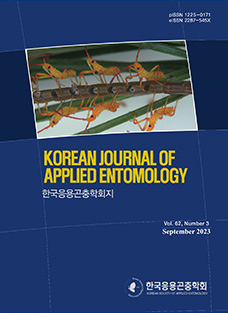The family Stathmopodidae, first reported in 1913, has since been documented worldwide with more than 40 genera and 400 species (van Nieukerken et al., 2011). Species belonging to this family exhibit diverse ecological characteristics, with larvae feeding on various crops, pine trees, mosses, and fern spores, or displaying carnivorous behavior by consuming spider eggs and aphids (Downes, 1994;Terada, 2016). In particular, given that fern spore consumption is known from only four families among micro-moths, further research on these taxa is important for elucidating their evolutionary relationships (Zimmerman, 1978;Lees and Zilli, 2019;Fuentes-Jacques et al., 2022). In Korean Peninsula, the first report of fern spore-consuming species within the family Stathmopodidae was Cuprina fuscella Sinev, followed by Calicotis latebrifica Terada (Koo et al., 2018;Sohn, 2023). In this study, we additionally report C. chrysopteraTerada, 2016, providing photographs, descriptions, and Field Emission Scanning Electron Microscope (FE-SEM) imaging to further document and expand knowledge of its distribution and morphological diversity.
Materials and Methods
Collection
Specimens were collected using light traps (mercury vapor lamp, 220 V/400 W) and bucket traps (black light, 12 V/20 W). The specimens were pinned through the thorax with wings spread and then dried in an oven at 50°C for at least three weeks.
Identification
For identification, dissections followed the protocol described by Kim et al. (2017). All dissections were performed under an EZ4 stereomicroscope (Leica, Germany). Photographs of the adults and their genitalia were taken using a Leica S8APO stereomicroscope (Leica, Germany) equipped with a Tucsen Dhyana 400 DC digital camera (Tucsen, China) and a Leica LED 5000 HDI dome illuminator (Leica, Germany). Multifocal images were merged into single photographs using Mosaic software (Tucsen, China) and Helicon Focus software (Helicon Soft, Ukraine), and the final images were edited with Adobe Photoshop 2024 (Adobe, USA).
SEM imaging
A conductive carbon double-sided tape 5mm (Nissin EM Co., Japan) was attached to the SEM plate. The plate with the attached sample was coated with platinum for 90 seconds using a Leica EM ACE200 (Leica, Germany) under vacuum conditions created by an Adixen 2005 SD vacuum pump (PFEIFFER VACUUM, Germany). Imaging was performed using a Gemini 500 FE-SEM (Carl Zeiss, Germany) in the Center for University-wide Research Facilities (CURE) at Jeonbuk National University, with sample adjustment and movement controlled via ZEN core Documentation (Carl Zeiss, Germany).
Results
Taxonomic accounts
Family Stathmopodidae Meyrick, 1913
Stathmopodidae Meyrick, 1913: 310. Type genus. Stathmopoda Herrich-Schäffer
Genus CalicotisMeyrick, 1889
CalicotisMeyrick, 1889: 170. Type species. Calicotis cruciferaMeyrick, 1889
Calicotis chrysopteraTerada, 2016 (신칭: 금줄홀씨꼭지나 방) (Figs. 1–2)
Stathmopoda sp. 3: Oku, 2003. Type locality. Japan
Stathmopoda sp. 3: Terada and Sakamaki, 2013
Calicotis chrysopteraTerada, 2016: 124
Materials examined. 3 individuals: 1 male, Baekgok-ri, Mado-myeon, Hwaseong-si, GG, Korea, 21.vii.2019, M. Yeom, gen. slide. No. IPE JBNU-13273/ I.W. Jeong; 1 individual, Baekgok-ri, Mado-myeon, Hwaseong-si, GG, Korea, 21.viii.2019, M. Yeom; 1 male, Geumgap-ri 980, Uisin-myeon, Jindo-gun, JN, Korea (34°22'3'', 126°17'47''), 30.vii.2023, Kim et al., gen. slide. No. IPE JBNU-13264/ I.W. Jeong.
Diagnosis. This species is similar to C. latebrifica Terada and C. rotundinidus Terada, but the marking of the forewing differs. In C. latebrifica, from base to 2/5 of costal and markings are grayish brown. In C. rotundinidus, have a pale grayishbrown spot near the base. But in this species, there is no spot near the base and the markings are pale ocher. In male genitalia, this species is similar to C. exclamationis Terada, but has differences from gnathos and sacculus. In C. exclamationis, it has relatively broad gnathos and a short sacculus that is concave in the middle. But in this species, it has narrow gnathos and a 1.5 times longer sacculus that is convex at 2/3.
Description.Adult. wing span 7.6-8.0 mm. Head white. Antenna pale ocher with grayish apex. Labial palpus yellowish white. Thorax yellowish white. Abdomen ocher with pale yellow scales at each segment caudally. Forewing yellowish white; costal pale grayish white; pale ocherous streak on CuP from 2/11 to 6/11; pale ocherous fascia oblique bar-shaped at the median; pale ocherous blotch at 5/7; fringes pale gray. Hindwing pale gray; costal gray; in male, one frenulum originating from three pairs of strands; scale with evenly spaced grooves, each groove with relatively uniform-sized holes aligned in a straight line, disconnected partitions on both sides of each hole, partitions separating adjacent holes; fringes gray. Male genitalia. Uncus tapering with a blunt apex, numerous setae on lateral margin. Gnathos as long as uncus, tongueshaped with blunt apex. Valva with round apex; costa round dorsally; cucullus twice longer than uncus, narrow oval-shaped, numerous long setae at the inner surface; sacculus sclerotized with a blunt apex, concave near base and convex at 2/3, some setae ventrally. Vinculum with blunt apex; saccus 1.3 times longer than uncus. Juxta subpentagon. Anellar lobes weakly sclerotized with some setae. Aedeagus three times longer than uncus; weakly sclerotized wrinkles at vesica; cornutus absent..
Host.Thelypteris acuminata (Houtt.) C. V. Morton (Thelypteridaceae) and Pteridium aquilinum (L.) Kuhn (Dennstaedtiaceae) (Terada, 2016).
Distribution. Korea, Japan.









 KSAE
KSAE





